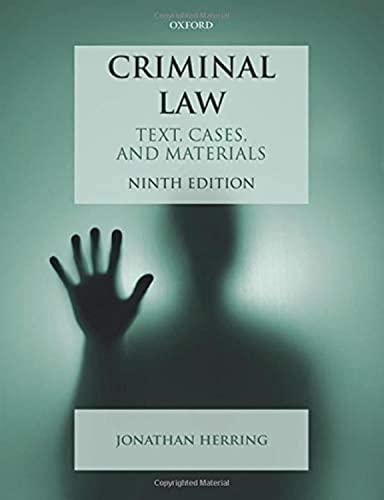Question
Complete a synopsis paper. Points will be awarded for reasoning, grammar, spelling, organization of material, content, and ability to evaluate, analyze and interpret data. Studies
Complete a synopsis paper. Points will be awarded for reasoning, grammar, spelling, organization of material, content, and ability to evaluate, analyze and interpret data. Studies should be retrieved from professional journals, abstracts, journals, or other appropriate sources. The articles should be related to a subject within the topic of white-collar crime. Use a U.S. based study not older than 5 years. Contain the appropriate sections with fully developed sections. Basically, a synopsis is a summary of the most relevant concepts, ideas, or information.
- A reader should be able to derive the relevancy of this article from your synopsis.
- You should have at least three main points that you derived from the article.
- Ideas for topics can come from the chapters in the text. I suggest you let the chapter titles guide your interest.
- You should begin with reading and highlighting the journal article or study.
- Next you should develop an outline.
- Remember that the introduction MUST specifically state exactly what your paper will present.
- Introduction
- This subject is relevant because...
- This synopsis will discuss: ___________, _________________, and ___________. (the blanks are your key points).
- Details of first key point
- Details of second key point
- Details of third key point
- Conclusion
This is a sample synopsis
Prison overcrowding is a major problem in the United States. Although crime rates have gradually been decreasing over the last few years, our prison population has continued to increase (Martin, Lichenstein, Jenkot, & Forde, 2012, p.89). According to the Bureau of Justice Statistics (2003) and Pryor (2005) "Southern prisons are among the most underfunded, understaffed, and crowded in the nation" (as cited in Martin, Lichtenstein, Jenkot, & Forde, 2012, p.89). A survey was collected from three Alabama correctional facilities. These surveys were completed by 66 correctional officers between the three different institutions. The survey covered subjects about overcrowding concerning job performance, health and safety, and inmate control (Martin, et al. 2012). This paper will discuss the questions proposed by the authors, the identification of participants involved in the study, the results of the surveys, and finally the limitations of this research.
These researchers proposed two questions that guided their research that included: (1) "Does crowding result in officer stress and work related illness" and (2) "Does crowding lead to violence or threats of violence" (Martin, et al. 2012, p. 92). Authorization was obtained from the Institutional review Boards at The University of Alabama and the Alabama Department of corrections to conduct this research.
Only male prisons were participants in this study and were identified as Facilities A, B, and C. Facilities A and B were both maximum-security prison and facility C was a medium-security prison. "The occupancy rates at these prisons far exceeded official capacity (Facility A= 154%, Facility B= 164%, Facility C= 206%)" (Martin, et al. 2012, p. 94). Participation for the surveys was decided at morning roll call at all institutions. If the officers chose to partake in the study, Martin would distribute the protocols to the contributors and gather the completed surveys in a designated collection box (Martin, et al. 2012, p. 94).
The results of the surveys revealed that officers view overcrowding in most negative terms. The officers, after completing the surveys, equally identified overcrowding as a threat to officer safety, job performance, and to poor health among both officers and inmates (Martin, et al. 2012, p. 95). Due to the overcrowding, the institutions become understaffed. Overtime is then used to compensate for the lack in staff. Prisoners are more likely to get away with devious behavior because there are not enough officers to monitor criminal activity.
The stress of these matters led to further health problems among officers and inmates. Some medical conditions included headaches, alcoholism, hypertension, obesity, heart attacks, diabetes, and weak immune systems (Martin, et al. 2012, p. 97). Crowded areas and poor sanitation lead to major diseases such as staphylococcus infections and tuberculosis. All officers were apprehensive about breaking up fights and disturbances among inmates due to those disease issues. One respondent wrote, "With more inmates, the threat of an incident or disturbance is definitely higher" (Martin, et al. 2012, p. 98). One officer went as far as saying, "This is a hostile and dangerous environment. We are spread thin; we sometimes have to monitor several hundred inmates by ourselves. We have become prey (A16)" (Martin, et al. 2012, p.99).
The outcome of this study shows that correctional officers have a hefty load regarding their work and that overcrowding has an effect on these officers in relation to their job performance and health is apparent. The consensus that overcrowding led to stress, concerns with safety, amplified violence, and sometimes job impairment, is evidence of how correctional officers view overcrowding in the most negative terms.
There are noted limitations to this study. The surveys were completed by officers "about occupational health and safety in crowded facilities and did not include the experiences of prisoners or officials whose views might have differed from those of correctional officers" (Martin, et al. 2012, p. 101). In addition, officers were not asked whether crowding had a direct impact on violence or whether the inmate to officer ratio was a bigger problem.
In conclusion, incarceration rates are increasing. The apparent fear in staff of these institutions is so great that it is diminishing their line of work. These issues are not likely to be solved unless government officials begin to address the problem of prison overcrowding.
Step by Step Solution
There are 3 Steps involved in it
Step: 1

Get Instant Access to Expert-Tailored Solutions
See step-by-step solutions with expert insights and AI powered tools for academic success
Step: 2

Step: 3

Ace Your Homework with AI
Get the answers you need in no time with our AI-driven, step-by-step assistance
Get Started


